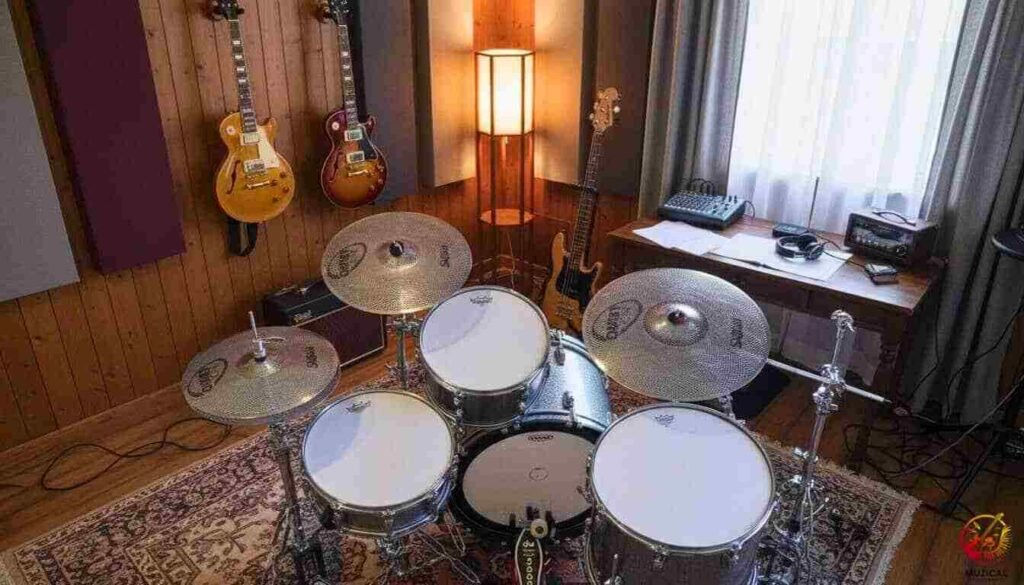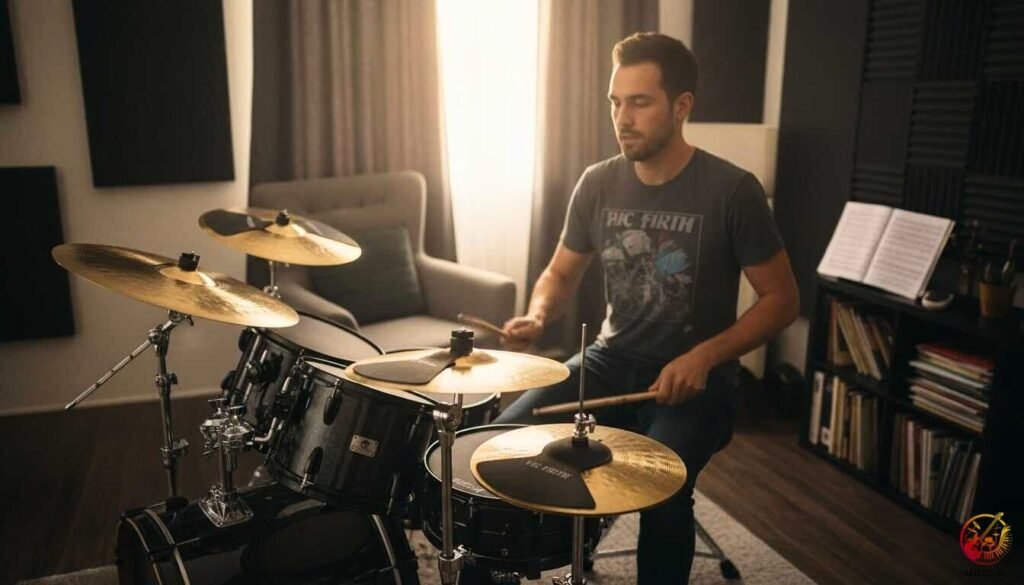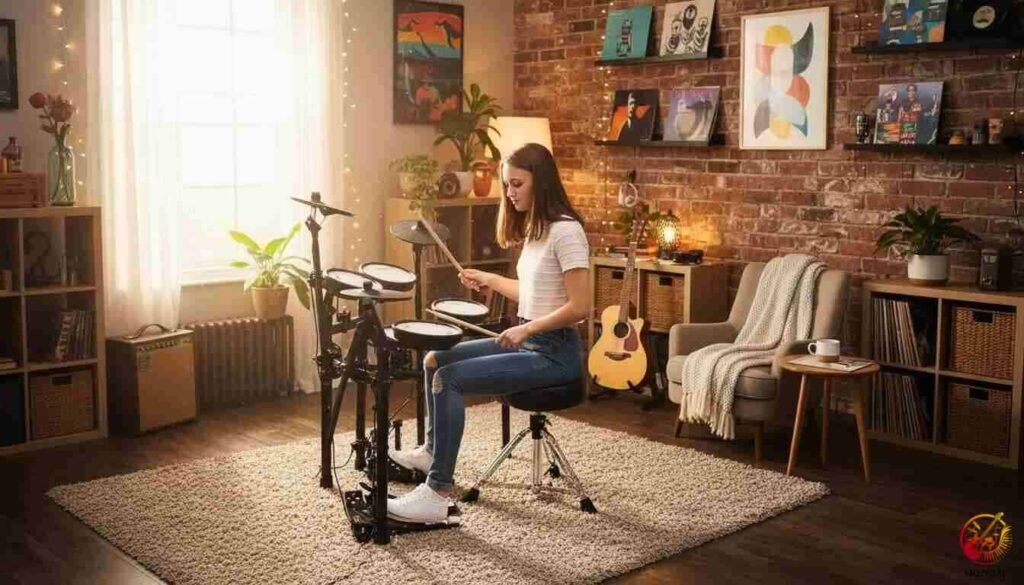How to Reduce Drum Noise Without Losing Feel
Learning how to reduce drum noise is the first problem every drummer has to solve, usually right after their family or neighbors complain for the first time.
So many tools exist to make drums quieter: practice pads, mesh heads, mutes, electronic drum kits, towels, and probably 10x other “hacks” you’ve seen online.
Which one is best?
To know that, we’ve tested, compared, and broken just about every quiet drum practice tool on the market.
If you want to find out (1) which one is quietest and (2) which one feels the most like playing real drums, keep reading.
The Best Way to Reduce Drum Noise

Out of 8 methods, the Hybrid Kit is the clear winner.
A “hybrid kit” isn’t a single product. It’s a combination of two key components on your existing acoustic drums:
- Mesh Drum Heads (like Remo Silentstroke)
- Low Volume Cymbals (like Zildjian L80)
This setup is the only one that delivers a massive (80-90%) noise reduction while keeping the real size, spacing, and stick rebound of an acoustic kit. It’s the best way to practice drums silently and still feel like you’re practicing at all.
We’ll break down the other methods, but this is the setup we recommend to every drummer who needs a serious silent drum setup at home.
Why Is Drum Noise So Hard to Control?
Before we get to the methods, you need to know what you’re fighting. If you get this wrong, you’ll waste hundreds of dollars.
It’s Two Types of Noise, Not One
Your drums create two kinds of noise.
- Airborne Noise (The “Boom” and “Crash”): This is the sound you hear, the crack of the snare, the crash of the cymbal. These are sound waves traveling through the air. This is what annoys people in the same room.
- Impact Noise (The “Thud”): This is the low frequency vibration that travels through solid things, your drum hardware, the floor, the walls. This is what your neighbors below and next door hate. The main culprit is your bass drum kick pedal hitting the floor.
Beginner Mistake: Only Treating Airborne Noise
This is the most common mistake.
A drummer thinks, “My drums are loud, I’ll put foam on the walls!”
Here’s the truth: That foam does almost nothing.
Egg crate foam, acoustic panels, and blankets on the walls are for sound absorption. They stop echo and make a room sound better. They do NOT stop sound from leaving the room. And they do absolutely nothing to stop the impact noise from your kick drum thumping through the building’s frame.
To reduce drum noise at home effectively, you must attack both airborne noise and impact noise at their source.
8 Methods to Make Drums Quieter
Here’s the breakdown of our tests. We rated each method on three simple things:
- Noise Cut: How quiet is it? (1-10)
- Real Feel: Does it feel like real drumming? (1-10)
- Cost: How expensive is it? ($ – $$$$)
Method 1: Drum Mutes / Practice Pads

These are thick rubber pads (like Evans SoundOff or Vic Firth Mutes) that you lay on top of your drums and cymbals.
- Noise Cut: 9/10 (They are very quiet. You just hear a “thwack”.)
- Real Feel: 2/10 (This is the problem. The feel is awful. It’s like playing on a car tire. The stick rebound is all wrong, and there is zero drum tone.)
- Cost: $40 – $100
Verdict: They work, but they are not fun to play. It’s hard to practice real dynamics (playing loud and soft) when every hit feels dead.
Method 2: Towels and T-Shirts (The “Free” Hack)

This is the classic “I have no money” solution. You just drape old towels or t-shirts over your drums and cymbals.
- Noise Cut: 6/10
- Real Feel: 1/10 (Even worse than pads. The towels kill every bit of rebound. Your sticks just die on the head.)
- Cost: (Free!)
Verdict: Don’t do this unless you are absolutely desperate. It teaches you bad technique because you have to pull the stick back up after every hit.
Method 3: Gels and Dampening Rings
These are products like Moongels or Evans E-Rings. You put them on your drum heads to control the sound.
- Noise Cut: 2/10
- Real Feel: 10/10
- Cost: $8 – $30
Verdict: This is a tone control tool, NOT a noise reduction tool. A common mistake is thinking these will make your drums quiet. They don’t. They just remove resonance (the “ring”) and make the drum sound “fatter.” This is for studio recording, not drum practice without noise.
Method 4: “Hot Rod” Sticks and Brushes
Hot Rods (or Rutes) are sticks made from a bundle of thin wooden dowels. Brushes are… well, brushes.
- Noise Cut: 5/10 (They are quieter than regular sticks, but a cymbal crash is still a cymbal crash.)
- Real Feel: 7/10 (You can use all your normal technique. It feels great.)
- Cost: $10 – $40
Verdict: This is a great solution for lowering the volume in a live band setting, like an acoustic coffee shop gig. It is NOT a solution for practicing in an apartment. It’s still too loud.
Method 5: Mesh Drum Heads (The “Acoustic” Winner)
These are drum heads made of a fine mesh (like Remo Silentstroke or Evans dB One). They replace your normal plastic drum heads.
- Noise Cut: 9/10 (They are shockingly quiet. It’s just a soft “tap.”)
- Real Feel: 8/10 (The feel is fantastic! The stick rebound is very close to a real head, and you can even tune them to get the right tension. This is the key.)
- Cost: $70 – $300
Verdict: This is half of the perfect solution. You get all the feel of playing your real kit, but with almost no airborne noise. But what about the cymbals?
Method 6: Low-Volume Cymbals (The “Cymbal” Winner)
These are cymbals made of a special metal alloy and drilled with thousands of tiny holes (like Zildjian L80s or Sabian Quiet Tones).
- Noise Cut: 8/10 (They are about 80% quieter than a real cymbal but still have a clear, musical “tshh” sound.)
- Real Feel: 9/10 (They feel exactly like real cymbals. They swing, they crash, you can ride on the bell. It’s a game-changer.)
- Cost: $60 – $400 (This is the downside. They are expensive, but they last forever.)
Verdict: This is the other half of the perfect solution. When you combine mesh heads and low volume cymbals, you get a kit that is 80-90% quieter but feels 90% real.
Method 7: The Electronic Drum Kit (E-Kit)

This is the obvious solution many people jump to. A full kit with rubber or mesh pads and a “brain” module.
- Noise Cut: 10/10 (With headphones, there is zero airborne noise.)
- Real Feel: 6/10 (Even on expensive kits, the feel is different. The cymbals are often stiff, and the pad spacing is smaller. It’s just not the same as a 22″ bass drum.)
- Cost: $170 – $10000
Verdict: This is a great tool, but it doesn’t solve the impact noise problem. The “thwack” of the sticks on the pads and the “thud” of the kick pedal can still be very loud to neighbors. It also doesn’t feel the same, which is our main goal.
Method 8: Kick Drum Muffling
The bass drum is a special problem. Even with a mesh head, the thump of the beater hitting the head and the pedal moving can travel.
- Solutions:
- Mesh Head + Kick Patch: Put a mesh head on the bass drum and add a small, solid patch (like an Evans EQ patch) where the beater hits. This gives you a soft “thud” with a bit of attack.
- Softer Beater: Replace your felt beater with a fleece or foam one.
- Beaterless Trigger: A device like the Roland KT-9 is a pedal that has no beater at all, designed to be ultra-quiet.
Verdict: You MUST address the kick drum separately. A mesh head is the first step.
Drum Muffling Comparison Tables
Let’s make this simple. Here are the two main choices you have to make.
Acoustic Muffling Methods Compared
| Method | Noise Reduction (%) | Feel (1-10) | Good For |
|---|---|---|---|
| Rubber Mutes/Pads | ~90% | 2/10 | Getting quiet on a low budget. |
| Towels/Hacks | ~60% | 1/10 | Absolutely nothing. Avoid it. |
| Hot Rods | ~40% | 7/10 | Lowering volume for a live gig. |
| Mesh Heads | ~90% | 8/10 | Quiet practice with a real feel. |
| Low-Volume Cymbals | ~80% | 9/10 | The only way to quiet cymbals. |
Hybrid Kit vs. Electronic Kit
This table compares our winning “Hybrid” setup (Mesh Heads + Low-Volume Cymbals) to a standard Electronic Kit.
| Feature | Hybrid Kit (on your acoustic) | Electronic Kit |
|---|---|---|
| Airborne Noise | Very Low (soft taps) | None (with headphones) |
| Impact Noise | High (kick drum on floor) | High (kick pedal on floor) |
| “Real” Feel | Excellent (9/10) | Good (6/10) |
| Size/Spacing | 100% like your real kit. | Smaller, more compact. |
| Cost | $550 (if you own a kit) | $170 – $10000 |
| Portability | Low | High |
Takeaway: Both setups fail to solve impact noise on their own. But the Hybrid Kit gives a much more realistic feel for acoustic drum noise reduction.
How Do I Stop My Drums from Vibrating Through the Floor?
This is the most important part of drum noise control.
You have to solve the impact noise. Even with a silent e-kit or a hybrid kit, the thud-thud-thud of your kick pedal and hi-hat stand will travel through the floor.
The only way to stop this is decoupling.
Decoupling means creating a break so the vibrations from your kit can’t get into the floor. You need to build an isolation platform, also known as a drum riser.
You can buy one (like the Auralex Gramma), but they are expensive. Here is how to build the famous “Tennis Ball Riser” for cheap.
DIY Solution: The Tennis Ball Riser
This platform floats your entire kit (and you) on a layer of air (inside tennis balls), which stops vibrations cold.
What you need:
- Two 4’x8′ sheets of MDF or Plywood (1/2″ or 3/4″ thick)
- A box of 20-30 tennis balls
- A drill
- A small piece of carpet
How to build it:
- Cut the Wood: Have the hardware store cut both wood sheets to the size you need (e.g., 4’x6′).
- Drill Holes: On one of the sheets, drill 2.5″ wide holes (using a hole saw bit) in a grid pattern, about 1 foot apart. These holes will hold the tennis balls.
- Add Balls: Place the tennis balls into the holes you drilled.
- Make the “Sandwich”: Place the other (solid) sheet of wood on top of the sheet with the tennis balls. The balls are now sandwiched between the two boards.
- Finish: Lay the carpet on top. Put your drum throne, kick pedal, and hi-hat stand on the platform.
Why this works: The vibration from your kick pedal goes into the top board, through the tennis balls (which absorb the shock), and stops at the bottom board. The vibration that reaches the actual floor is almost zero.
This is the single most effective thing you can do for a soundproof drum room setup.
Best of Setups for Quiet Drum Practice
Here are three setups you can copy, based on my tests.
1. The “Apartment Dweller” Setup (Best Overall)
This is the winning hybrid solution. Max quiet, max feel.
- Drums: Remo Silentstroke Mesh Heads
- Cymbals: Zildjian L80 Low-Volume Cymbals
- Floor: DIY Tennis Ball Riser
- Kick Beater: A standard felt beater (the mesh head makes it quiet)
2. The “Budget-Friendly” Setup
This is for when you’re broke but need to practice.
- Drums: Evans SoundOff Rubber Mutes
- Cymbals: Evans Cymbal Mutes (or towels)
- Floor: A thick, folded-up rug or yoga mat (won’t stop it all, but it’s better than nothing)
- Kick Beater: Put a thick, old sock over your beater.
3. The “Studio” Setup (Tone Control Only)
This is NOT for quiet practice. This is for making your drums sound better.
- Drums: Moongels or Evans E-Rings
- Sticks: Regular sticks, with Hot Rods nearby for quieter parts
- Floor: A simple rug (to stop the kit from sliding)
Final Thoughts: Stop Muffling, Start Isolating
After testing everything, it’s clear.
The challenge of how to reduce drum noise isn’t just about making things sound quiet; it’s about making them feel right.
The Hybrid Kit (Mesh Heads + Low-Volume Cymbals) is the clear winner for solving airborne noise without losing the feel.
But the real secret? Stop focusing on the walls and start focusing on the floor. Building a DIY Tennis Ball Riser to stop impact noise will do more for your neighbors than any amount of foam ever will.
Combine the hybrid kit with the isolation riser, and you’ve built the perfect silent drum setup that lets you practice any time you want.
FAQ: How to Reduce Drum Noise
1. How can I practice my drums quietly at home?
The easiest way is to buy rubber mute pads that you lay on top of your regular drums and cymbals. For a much better feel, you can swap your normal drum heads for mesh (fabric) heads and use special low-volume cymbals.
2. Is it expensive to soundproof a drum room?
Yes, real soundproofing is very expensive. It means building new walls and floors to stop sound from escaping. Putting foam panels on the wall will not stop the noise for your neighbors; it only stops the echo inside your room.
3. Will putting a pillow in my bass drum make it quieter?
Absolutely! A pillow or blanket inside your bass drum is a great trick. It soaks up the loud “boom” and gives you a much quieter, punchy “thud” sound that doesn’t travel as far.
4. What’s better: mesh heads or rubber pads?
Mesh heads feel much better. They have a bounce that feels like a real drum, so you can practice properly. Rubber pads are cheaper, but they feel mushy and dead, with no stick bounce.
5. Are electronic drums completely silent?
They are the quietest option, since all the drum sounds go into your headphones. However, your family or neighbors might still hear the thwack of your sticks hitting the pads and the thump of your kick pedal hitting the floor.
